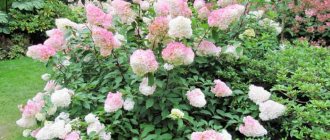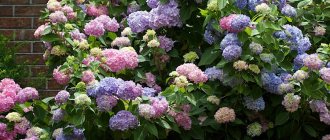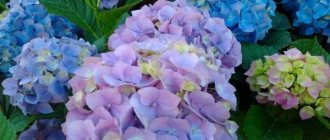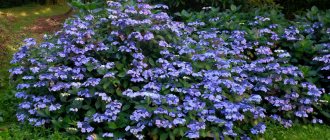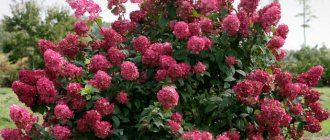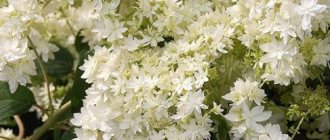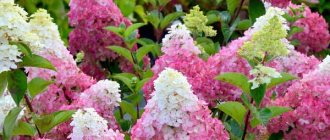Ground hydrangea is very easy to grow. It is unpretentious in care if you know the basic rules for growing it: choose the right soil, moisten it in time and preserve the flowers in the cold. The most difficult stage will be caring for the young seedling - you will have to constantly look after the fragile plant. read about the most spectacular and sustainable varieties in Siberia and the basic rules of care.
Hydrangea in open ground in Siberia 1.1 Paniculate hydrangea in garden design 2. Hydrangea varieties for growing in Siberia 3. Flower care in the Siberian region 3.1 How to plant a bush 3.2 How to water and feed 3.3 How to prune and cover hydrangea for the winter
Photo: varieties of paniculata hydrangea for growing in Siberia.
The best varieties of paniculata hydrangea for Siberia
The varietal variety of paniculate hydrangeas is optimal for agricultural technology at low temperatures, since these flowers are characterized by good frost resistance. Moreover, their impressive size, elongated inflorescences and attractive colors are widely popular in decorating parks and garden areas.
Did you know? The Japanese call hydrangea the word Ajisai, which translates as “a flower that resembles the purple sun.”
Flower growers in Siberia are recommended to give preference to the following varieties of paniculate flowers:
- Vanilla Fresh;
- Bobo;
- Limelight;
- Medical Flute;
- Pink Diamond;
- Sunday Fresh;
- Medical Fire.
Bobo, Vanilla and Sandai Fresh are dwarf varietal varieties, growing no more than one meter in height. All others can form impressive shrubs, up to 10 m high.
Trimming
The hydrangea bush should be shaped so that it always has a well-groomed appearance. In autumn, after flowering is completed, it is necessary to remove faded inflorescences.
In the spring, before the sap begins to flow, it is necessary to cut off all the shoots of the tree hydrangea, leaving 5 buds. The paniculate variety is pruned a little differently - the main shoots are cut to the desired height, and the side shoots are reduced to three buds.
It is necessary to regularly rejuvenate old bushes, cutting off all branches and leaving stumps of 7-8 cm - new shoots will appear very quickly.
Landing
The procedure for planting a crop in Siberia will not require much effort from the gardener, since it includes the same steps as with any other flower, namely, choosing a planting site, digging and preparing a hole.
Important! Do not plant hydrangea on alkaline soils, as it will take root poorly and grow slowly.
Its decorative qualities will also suffer
Selecting a location
Hydrangea has its own requirements for the planting site. The place must be protected from piercing Siberian winds and drafts. Panicle varieties do not like direct sunlight, so they need to be provided with growing conditions in partial shade. Open areas should be avoided. It is best to choose places for culture under walls or fences.
As for the type of soil, preference should be given to slightly or moderately acidic soils, which should include turf soil, peat, humus, leaves and sand. Adding pine needles to the hole will help increase the acidity of the soil.
Also find out what kind of soil is needed for planting garden hydrangea.
Pit preparation
After choosing a site, you should start preparing the hole, which includes the following steps:
- Direct digging. If the seedlings are of medium size, then the parameters of the planting holes should be 50x50 cm, for large seedlings - 80x80 cm. The standard depth is 60 cm.
- Filling the hole with water. Each will require 3 buckets. All this is left for one night so that the liquid is completely absorbed into the ground.
- Substrate preparation. The nutritious soil mixture should include parts of turf soil, humus, sand, peat in proportions of 2:2:1:1 and fertilizers (20 g of urea, 20 g of potassium and 60 g of superphosphate).
- Preparing a seedling for planting. The shoots are cut to the level of 5-6 buds, and small roots are also shortened.
- Place the seedling in a new location and fill the hole with substrate. The root collar of the plant should be above the top soil layer.
How to choose the right seedling.
Initially, the gardener faces a very important task: choosing the right seedling for planting. First of all, you need to pay attention to the soil in which the hydrangea grows. There must be a lump of earth on the root system of the seedling, which must be moist and uniform. Also, the shoots of the plant must be of sufficient length, healthy, without damage and always flexible.
It is best to buy a seedling just before planting. Of course, it is best not to store the seedlings, but if for some reason it is not possible to plant them immediately, then it is imperative to comply with the conditions for storing the seedlings before planting: the earthen ball on the roots should always be moist and located in a dry and well-ventilated place.
Plant care
Caring for hydrangea in Siberia is essentially no different from growing it in any other regions. Mandatory items are watering, mulching the tree trunk, pruning and fertilizing procedures.
Watering
The flower in question is extremely fond of moisture, and therefore needs regular watering. As a rule, hydrangea is watered twice every 7 days. The gardener must ensure that the soil around the hydrangea is always moist. So, if the weather remains dry outside for a long time, then it is worth moisturizing the crop daily. The optimal amount of liquid for one plant is 10 liters.
Important! Hydrangea will delight you with its especially lush and spectacular inflorescences if you periodically (for example, once every 2 weeks) add potassium permanganate (1 g per 1 liter) to the watering liquid.
The shrub also makes special demands on the quality of water: it must be soft - hard water will have a bad effect on the life of the plant, so it is best to use rain, melt, settled or filtered water for this purpose. Vinegar (about 5 tbsp per bucket) or lemon juice squeezed from one citrus fruit for 10 liters of water will help soften the liquid.
Mulching
Covering the soil with mulch is a mandatory measure for caring for paniculate varietal varieties of crops growing in Siberia, since mulch is responsible for the function of preserving moisture in the soil layer. It is recommended to mulch the soil around the plant trunk using wood chips, peat chips, pine needles or leaves. The mulch layer should be about 10 cm thick.
Trimming
Giving paniculate varieties of hydrangea a good decorative shape is done through regular pruning. Spring procedures consist of shortening last year's shoots by a third of their length. Damaged, weak branches, as well as those that grow inside the bush, are completely eliminated.
Important! Until the plant is 3-4 years old, pruning it is prohibited.
Young people should not be touched. In the fall, it is worth removing all the inflorescences that have bloomed. If the shrub is no longer young, then in autumn all its shoots need to be shortened so that their length does not exceed 5-6 cm above the soil level.
Feeding
In order for the plant to feel good, grow well and bloom profusely, it must be fertilized regularly.
We recommend reading about diseases and pests of paniculate hydrangea and methods of combating them.
If in warm regions fertilizing is applied twice per season, then in harsh Siberian conditions the plant must be fed 4 times:
- In early spring, approximately the beginning - mid-May. For every 1 m² of area, urea (20–25 g), superphosphate (about 30 g) and potassium sulfate (20 g) are added. After 2 weeks, fertilization with these substances is repeated.
- During the budding period. The crop is fed simultaneously with watering. Superphosphate (70–80 g) and potassium sulfate (about 50 g) are diluted in 10 liters of water and the shrubs are watered with this nutrient solution.
- After flowering, a certain amount of manure or humus (6-7 kg) is placed under each bush.
Diseases and pests.
Hydrangeas, just like other plants, experience diseases. Although this is a fairly rare occurrence, it can still happen at absolutely any time.
Among hydrangeas there is a disease called chlorosis. It appears due to the fact that the plant grows for a very long time in the same place and does not receive proper fertilizer. Because of this disease, the leaves of the bush begin to turn yellow. If treatment is not started in time, the bush will gradually begin to weaken and eventually die. As a preventative measure, as well as treatment itself, medications that contain iron are suitable. Hydrangea is also often affected by diseases such as gray and white rot, powdery mildew, and septoria.
These are all fungal diseases that can live both on the leaves of a plant and simply in the ground. Initially, they may not show their existence in any way, but as soon as you make a mistake in caring for the bush, and it doesn’t matter which one, the disease can very quickly show itself in all its glory and the fungus will begin to develop very quickly and destroy your plant.
If you are affected by a disease, the sooner you start treatment, the easier it will be, and the less harm it will cause. First of all, at the early stage of the disease, spraying the bushes with special preparations helps. And those parts of the bush that were nevertheless affected must be removed from the bush and burned outside the site.
In addition to the fact that hydrangea has diseases, it can also be attacked by pests. This could be aphids, snails, spider mites, etc.
It is much easier to fight pests; when they first appear, the bushes need to be sprayed with special preparations, but if this is not done and the pests remain, they can destroy the plant, and it will simply die.
Reproduction
The most popular methods of propagating paniculate hydrangea in Siberia are cuttings and sowing seeds. The first method is preferable, as it allows you to get results faster.
Did you know? Hortensia was named in honor of the sister of the French explorer,
Prince of Nassau-Siegen, who participated in a round-the-world expedition led by Louis Antoine de Bougainville. The prince kept telling his comrades about the indescribable beauty of his sister Hortense, so when they saw a lovely flower in the Mauritius Islands, they decided to name it after the girl.
Cuttings
It is preferable to carry out cuttings during the period when the plant is actively blooming. Leafy cuttings with two or three buds are cut from the bush. To do this, it is worth choosing side shoots from last year's growth. The petioles are placed in a growth stimulator (for example, Heteroauxin or Kornevin) for two hours.
Rooting should be carried out in open ground conditions, but it is recommended to cover future seedlings with film. For the winter, young plants are moved to a special container and then transported to closed, cool conditions. The seedling should be transplanted only in late spring of next year.
Seeds
Seed for cultivating hydrangea seedlings at home should be purchased at a specialized store.
Did you know? The blue color of hydrangea inflorescences is explained by the fact that the crop is able to absorb aluminum contained in acidic soils.
Next you need to follow the following steps:
- Before sowing, the purchased seed must be disinfected in a weak solution of potassium permanganate or copper sulfate.
- It is preferable to sow the seeds in February; they should be germinated first (put them on damp gauze or cotton wool and wait until they swell).
- While the seed is germinating, you need to prepare a substrate from equal parts of leaf soil, peat and sand. The substrate is placed in a container and seeds are placed on top of it, which are sprinkled with a little sand. Then the container is covered with film or glass.
- Twice a week, the planting material should be watered with a spray bottle, making sure that there is no excessive moisture.
- The first shoots will begin after 3-4 weeks. When the second leaves appear on the seedlings, they can be planted in separate containers.
- Only after 2 years can seedlings grown from seed be transplanted to a permanent location.
Top dressing
In order for this luxurious plant to delight you with large inflorescences and long flowering, it should be fed. Liquid manure is an organic fertilizer that is ideal for hydrangeas, but it should be used very carefully, since an excess of it will harm the inflorescences.
Mineral fertilizers are added during watering - 20-30 grams per ten liters of water. 2-3 buckets of solution are poured under one bush. Today there are many special preparations on sale that perfectly balance all the necessary nutrients for this particular shrub.
Garden hydrangeas are fed four times during the spring-summer season:
- 1 feeding - in early spring, when sap flow begins;
- 2nd - during the appearance and development of buds;
- 3 feeding - in mid-summer;
- 4 fertilizing is carried out in the fall, during preparation for winter.
Preparing for the Siberian winter
Preparing garden paniculate hydrangea for Siberian winters has its own characteristics. Even if you have planted the most frost-resistant variety of paniculate hydrangea on your site, it will not be able to survive the harsh Siberian winter if it is not covered and step-by-step procedures for preparing for the cold period are not carried out.
It may be useful for you to learn about planting hydrangeas in the Leningrad region.
Before the onset of frost and snow, you should take the following steps:
- Hilling up the plant with soil and mulching the tree trunk. It is recommended to use rotted manure, peat, pine needles, and dry leaves as mulch.
- Covering the bush with burlap or agrofibre. The branches of the plant should be bent to the ground and fixed. Then lay a layer of covering material, and sprinkle the so-called on top. heating materials (spruce branches, dry leaves, sawdust). For large bushes, it is worth forming a frame wire shelter - a kind of hut, which should rise 10 cm above the ground. The space in it is filled with leaves and covered with film.
- With the appearance of snow, it is worth making a snowdrift around the bush, which performs both protective and moisturizing functions.
So, hydrangeas can grow even in Siberia - you just need to provide this attractive garden flower with good care and follow all the rules of agricultural technology. In general, they are similar to those that operate in warm regions, they just have their own characteristics.
Description of the flower
Those who are interested in garden hydrangea planting and care in open ground in the Urals know very well what this flower looks like. We are talking about a perennial that can grow to a height of 2 meters. The plant has bright green ovate leaves and an erect stem.
Flowers can be of different shades: from white to bright purple. They are formed at the ends of the shoots and form into beautiful inflorescences in the shape of caps. The flowering period of hydrangea occurs in July and August.
Hydrangea inflorescences can have not only a spherical shape
Difficult climatic conditions have long been no longer an obstacle to growing flowers. The hydrangea flower has been grown quite actively in the Urals in recent years.
In order for a flower to feel comfortable in a fairly harsh climate, it is important to choose the right variety for planting.
general information
Basically, the species diversity of the plant is more represented in the form of shrubs and small trees, and less in the form of vines. They are divided into evergreen varieties and deciduous. Siberia belongs to the 3-4th climatic zone, which is characterized by the following conditions:
For successful cultivation, abundant flowering and reproduction, you need to follow several rules:
Advice! Seeds of some varieties may not have time to ripen in Siberian conditions, so it is better to propagate by cuttings or layering.
Examples in landscape design
Hydrangea can become the queen of landscape design even in Siberia. With its help, you can create a beautiful flower bed, greenhouse, or even make a hedge. It goes well with many plants in the garden, for example, with roses, and looks very advantageous with conifers, especially with thuja. Many gardeners plant hydrangea near large trees: birches, acacias or lilacs.
Thanks to a wide selection of colors, hydrangeas are of great value to gardeners, because with the help of this plant you can create any colorful mix that will delight you all summer.
It is not necessary to plant hydrangea with other plants in the neighborhood, because this plant is so beautiful that it looks amazing on its own, especially if several bushes of different colors are planted.
Gardeners leave a lot of positive reviews about winter-hardy varieties of hydrangeas, because with their help you can create a real summer paradise even in Siberian conditions. Hydrangeas grow very quickly, they are rarely attacked by pests, but still it is better not to rule out preventive measures.
How to care for hydrangea, see the following video.
General rules
Cacti are very unpretentious plants in their care. They are undemanding, as evidenced by their habitat. But this does not mean at all that, having planted an indoor cactus, you can forget about it and only water it occasionally. It grows in the desert, and therefore the last thing a cactus needs is water. But this is a common misconception.
Cacti, like all plants, simply need water, and any cactus grower knows this, so he carefully looks after his brainchild, lovingly watering it according to a strictly defined schedule. The cactus, like a sponge, absorbs the moisture donated by the owner, and then, like a thrifty housewife, gradually uses it up. Watering cacti is one of the most important items on the list of recommendations for caring for a prickly plant.
When watering a cactus, you should always remember the main rule: it is better to underwater than to overwater. Excess water displaces air from the soil, which inhibits the development of fungus and other bacteria.
Many people wonder what kind of water to irrigate the soil under cacti. Experts advise using either boiled or distilled water for irrigation. Melt water is also suitable for irrigation. Hard water is not suitable for irrigating the soil, so it is either passed through a filter to remove chlorine from it, or a little peat is added to it. The appearance of a white coating at the base of the trunk indicates that the water used for irrigation is not suitable.
The temperature of the water used for irrigation may vary depending on the season, and if in the summer watering is carried out with water at a temperature of +22.25 degrees, then in the cold months it is recommended to heat it to 45 degrees.
The process of watering is not familiar to everyone, and only true cactus growers know that it is impossible to get water on the plant trunk during watering. It is correct to water only the soil, from which the cactus then takes moisture.
Watering the plant in the form of spraying is permissible for cacti, only during this procedure it is necessary to point the tip not at the plant itself, but upward above it, so that small drops fall on the cactus in the form of dew. It is prohibited to spray succulents in a cool room.
Popular articles Gladioli flowering: how to speed up the onset and increase the duration
With the help of watering, cactus growers not only nourish the plant, but also add creativity to their appearance in the form of colored needles. Not everyone uses this decorative technique, but this type of watering does exist and is quite popular in cactus growing circles. To color needles, plants use water in which various food dyes are dissolved.
Garden decoration
Large-leaved hydrangea is so beautiful that it can decorate any garden. Huge clouds of inflorescences make it inimitable when placed alone on the lawn or at the entrance. A group composition of large-leaved hydrangeas of several varieties with different flower shapes, inflorescences and colors will look unusual.
In general compositions, the noble austerity of conifers emphasizes the lush brightness and rich flowering of hydrangea. It goes well with other ornamental shrubs - blooming one after another, they can decorate the garden all summer.
Large-leaved hydrangea with astilbe
Hydrangea looks wonderful surrounded by perennial flowers and ferns. It is only important to choose the color scheme. And hydrangea borders and hedges look fantastic! Foam waves of various shades will not leave anyone indifferent.
It may seem that large-leaved hydrangea is quite demanding in care. But with some effort, you will receive a reward in the form of a stunningly beautiful plant that will become the pearl and pride of your garden.
Source


